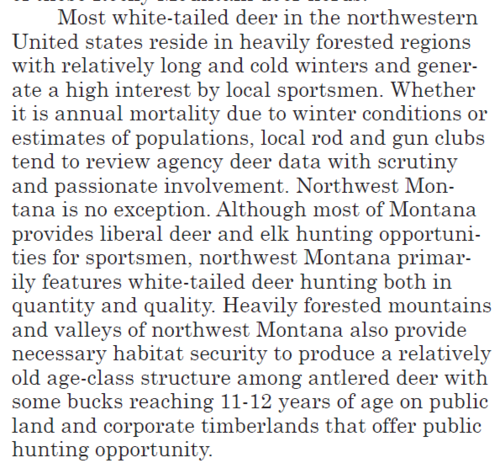Good evening folks. I hope you're tagged out and stress-free on your Thanksgiving weekend, and if not, I hope you shoot straight tomorrow/Sunday! Anyway, I have a question regarding the whitetail population in NW MT. While I'm not new to Montana, I'm relatively new to Eureka, as I'm only going on my 4th year of working/living/hunting up here. This is definitely now home, and I'm currently traversing the learning curve of hunting the area. Can anyone answer the following question: why are whitetails so abundant in the NW corner of the state? I'm by no means complaining. Having filled yet another tag this year, I'm thrilled to have another year's worth of delectable meat in the freezer. However, I am curious as to why they predominate up here as opposed to mule deer, which seem to have taken it on the chin in recent decades. Any thoughts?
Navigation
Install the app
How to install the app on iOS
Follow along with the video below to see how to install our site as a web app on your home screen.
Note: This feature may not be available in some browsers.
More options
You are using an out of date browser. It may not display this or other websites correctly.
You should upgrade or use an alternative browser.
You should upgrade or use an alternative browser.
Northwest MT Whitetail Question
- Thread starter RuralMT
- Start date
Attachments
Last edited:
T
timmy
Guest
And this is why timber whiteys are awesome. Amazes me the pressure they will live through. Whitetails that have cover aren’t much different than coyotes they find a way to survive.
Excellent, some winter-reading; thanks Sytes! I completely agree, they are a rather unique animal. I've enjoyed getting to know them and have come to appreciate their uniqueness. Having not grown up here, though, I'm curious if they've out-competed the mule deer, or if they're a niche animal taking advantage of under-utilized resources. Perhaps the extensive study Sytes attached will inform me.
El Jason
Well-known member
Do whitetail outnumber mule deer in the Idaho Panhandle?
Yes.
Deer don’t outcompete other per se, they are each suited better to different environments. As habitats change, it favors one animal over the other.
they are each suited better to different environments. As habitats change, it favors one animal over the other.
The crux of my inquiry. Has the decline in logging benefited the whitetail? Much of the U.S. might associate whitetails with farmland. Yet, they seem to be dominating the thick, steep forests of the Northern Rockies, which fascinates me. Were they up here when Lewis and Clark rolled through?
Ben Long
Well-known member
The Kootenai have a word for whitetail deer. (Their language is ancient and unique). So we know that WTD have lived here for thousands of years. Libby was a center for hide hunters who focused on WTD in the late 1800s, so they were fairly abundant then. So they are naturally well suited for the terrain. They reproduce well, so they can bounce back from the snow and predators. But I think that settlement has made it even better for WTD, with hay fields, hay stacks, and inadvertent supplemental feeding, along with more developed places with lower predator levels. I think as logging moved up the mountains, it created some new forage and habitat for WTD, but that's limited by snow much of the year. IMO the decline in logging has meant some older forests, overall, which means less food for WTD, and lower numbers. But that's only part of the picture. Two-legged and four-legged predators, disease outbreak may be something of a limiting factor, but snow pack is the big one, IMO.
Ben Long
Well-known member
There is something special indeed about hunting big woods bucks that have never seen a farm or a barbed wire fence, on their own terms, competing with wolves and lions, in really wild country!
Similar threads
- Replies
- 14
- Views
- 2K





